Abstract
The present studies were initiated to quantitate the oxygen dependence of bioreductive metabolism-induced binding of EF5, a pentafluorinated derivative of the 2-nitroimidazole, etanidazole. Two different assays were compared: first, radioactive drug incorporation into cell lysates, which provides a direct measure of drug metabolism or uptake; second, monoclonal antibody detection of cellular macromolecular adducts of EF5 after whole cell permeabilisation and fixing. The antibodies (a single clone designated ELK3-51) were conjugated with the fluorescent dye Cy3, with fluorescence determined by fluorescence microscopy and flow cytometry. For the two cell lines tested (V79 Chinese hamster fibroblasts and 9L rat glioma), the oxygen dependence of binding was found to be the same for the two techniques. Using the antibody binding technique, the fluorescence signal was highly reproducible between experiments, resistant to light or chemical bleaching and stable over time following cell or tissue staining. Flow cytometric analysis of cells from rat 9L tumours treated with EF5 in vivo or in vitro showed a distribution of fluorescent signal which was very compatible, on both a relative and absolute basis, with the in vitro results. Our results indicate that immunofluorescent techniques provide a quantitative assay for bioreductive drug adducts, and therefore may be able to measure the absolute oxygen concentration distribution in cell populations and tissues of interest.
Full text
PDF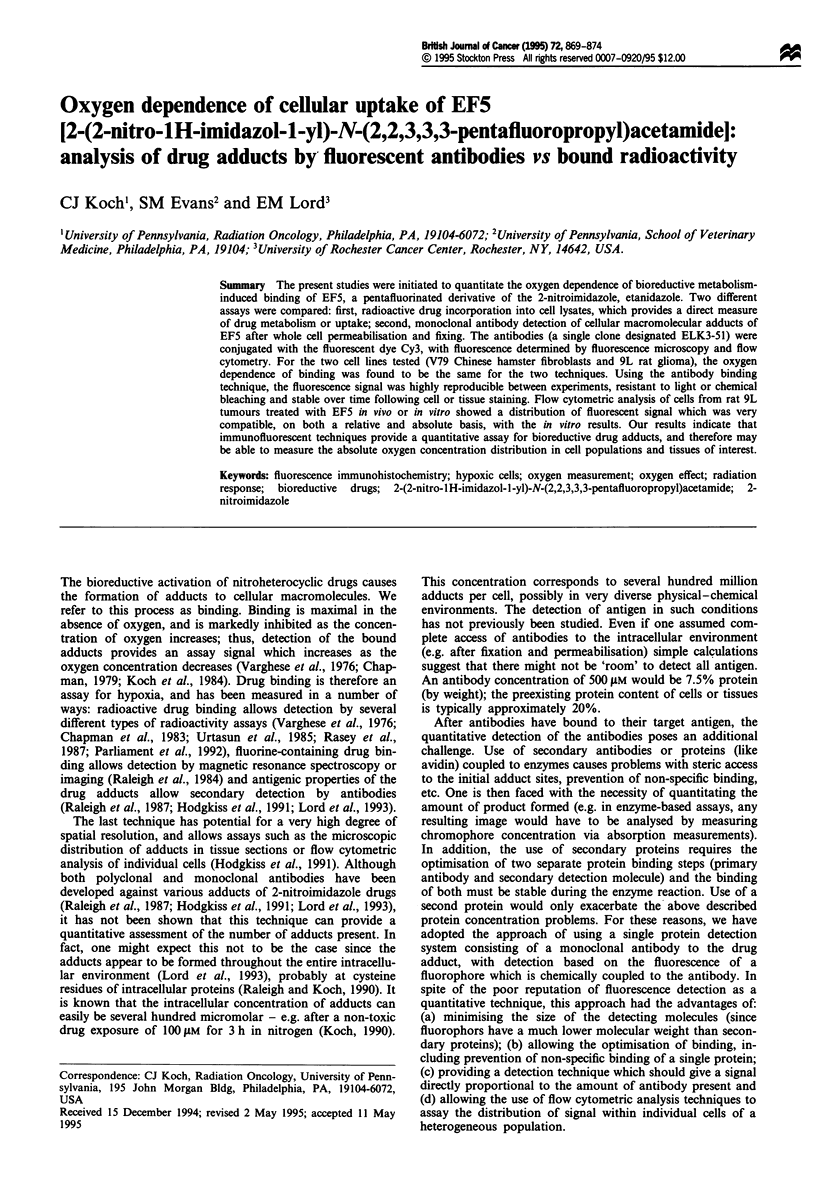
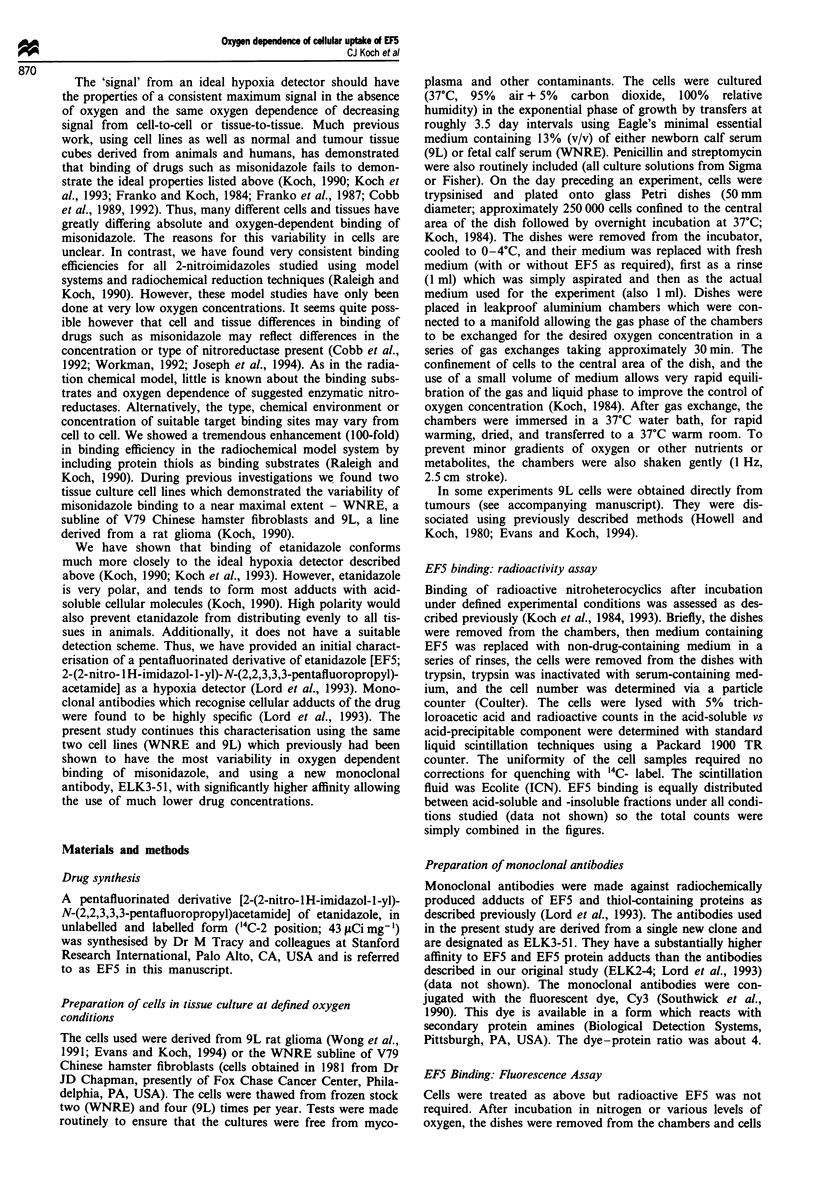
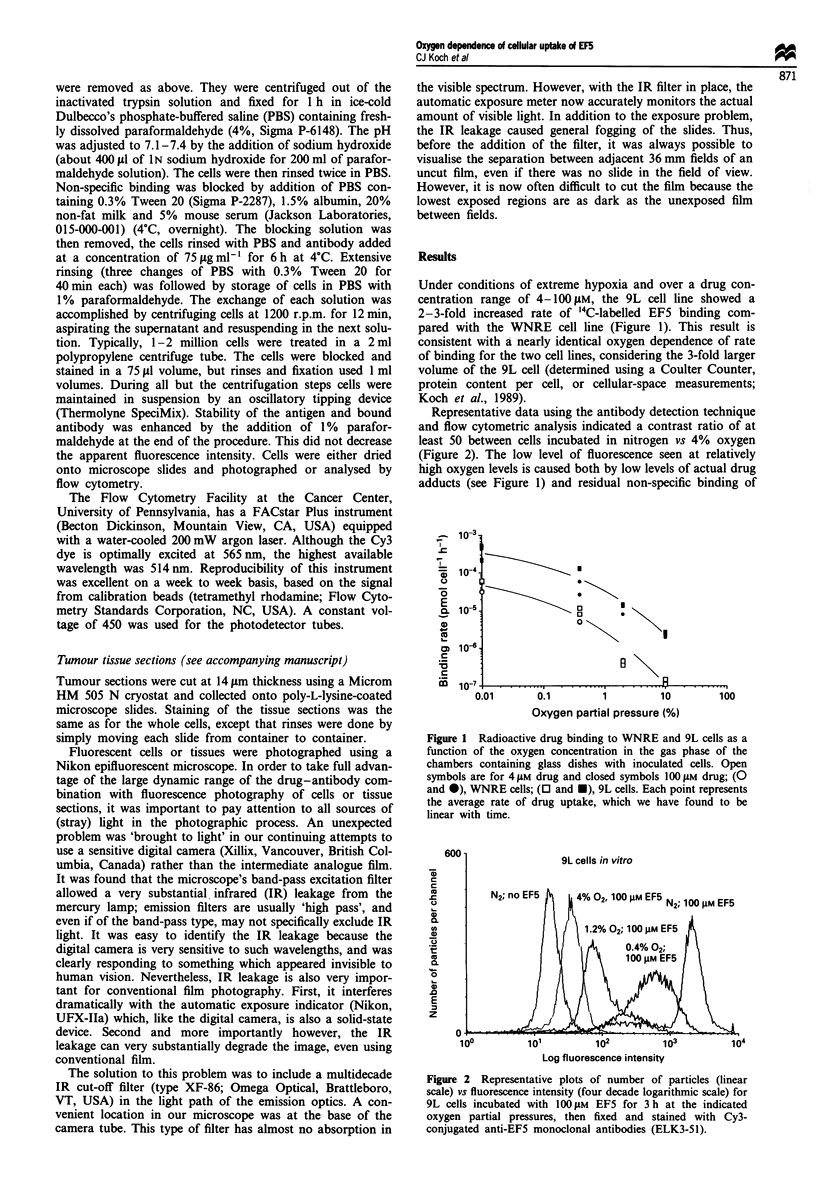
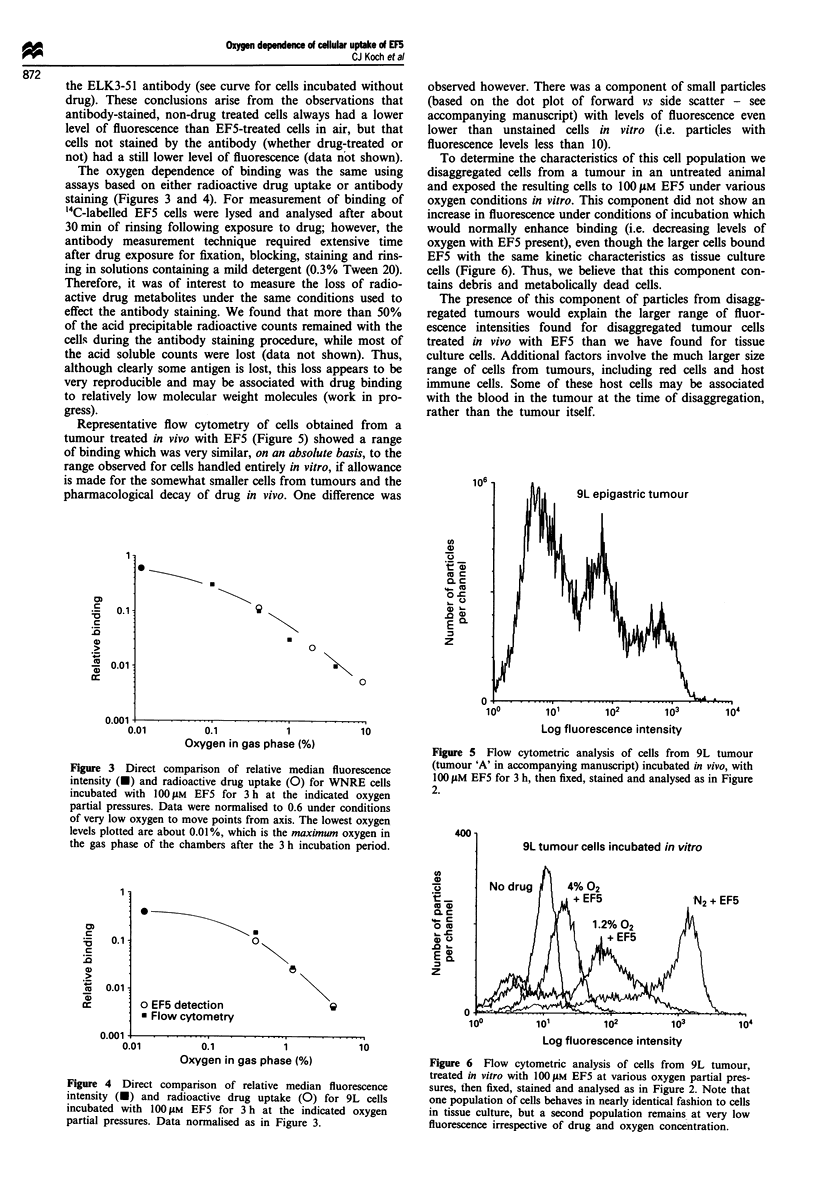
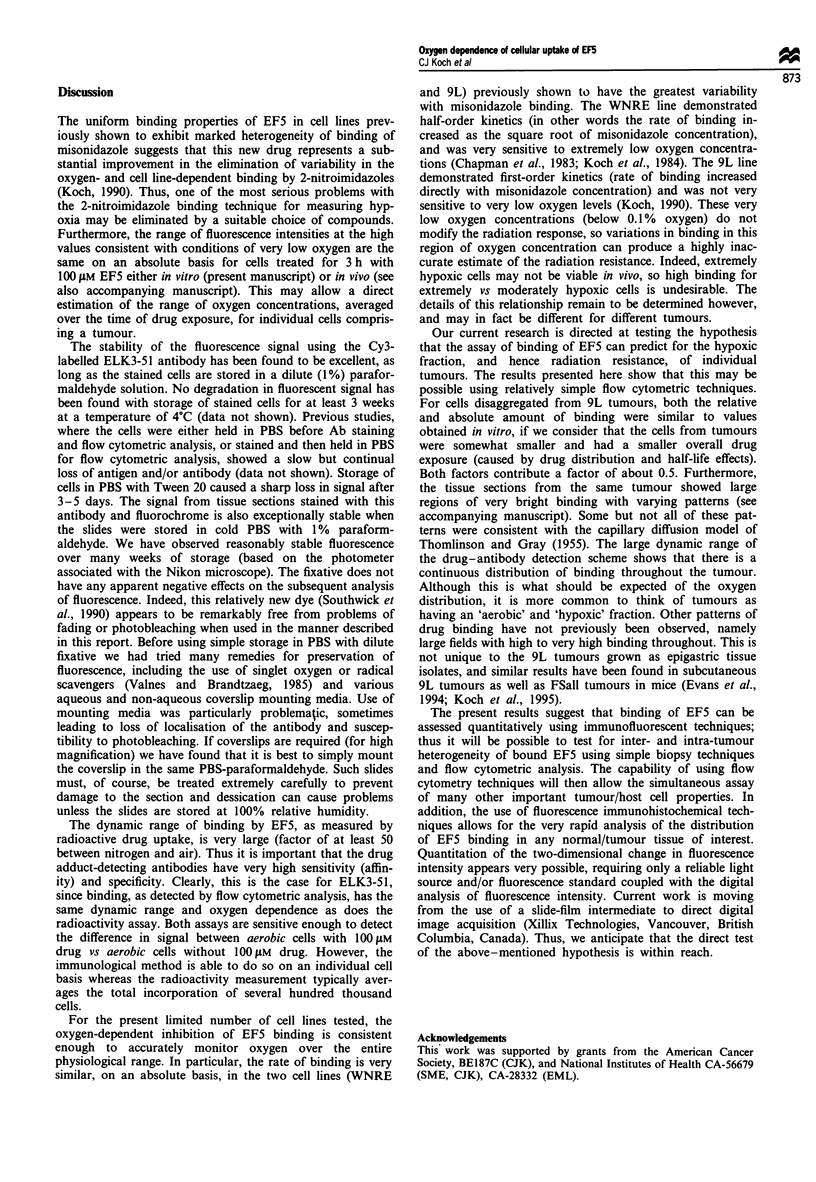
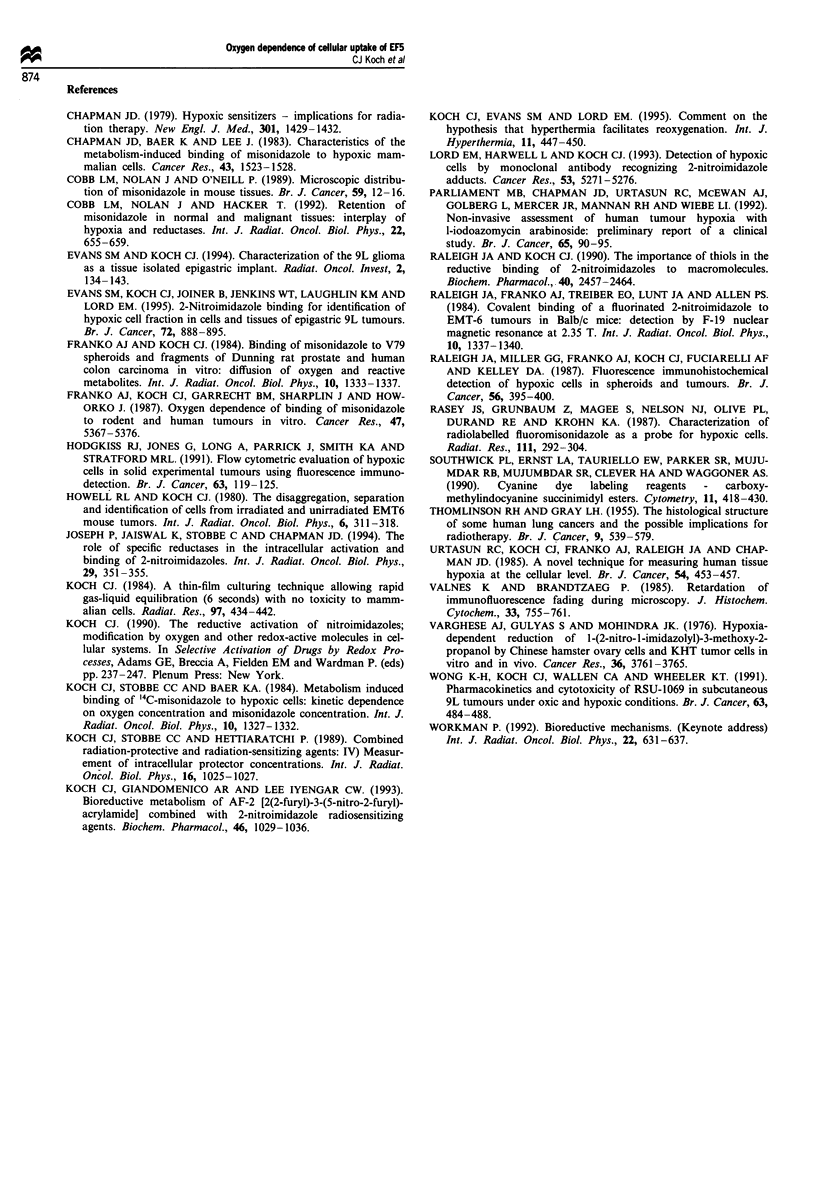
Selected References
These references are in PubMed. This may not be the complete list of references from this article.
- Chapman J. D., Baer K., Lee J. Characteristics of the metabolism-induced binding of misonidazole to hypoxic mammalian cells. Cancer Res. 1983 Apr;43(4):1523–1528. [PubMed] [Google Scholar]
- Chapman J. D. Hypoxic sensitizers--implications for radiation therapy. N Engl J Med. 1979 Dec 27;301(26):1429–1432. doi: 10.1056/NEJM197912273012606. [DOI] [PubMed] [Google Scholar]
- Cobb L. M., Nolan J., Hacker T. Retention of misonidazole in normal and malignant tissues: interplay of hypoxia and reductases. Int J Radiat Oncol Biol Phys. 1992;22(4):655–659. doi: 10.1016/0360-3016(92)90497-6. [DOI] [PubMed] [Google Scholar]
- Cobb L. M., Nolan J., O'Neill P. Microscopic distribution of misonidazole in mouse tissues. Br J Cancer. 1989 Jan;59(1):12–16. doi: 10.1038/bjc.1989.4. [DOI] [PMC free article] [PubMed] [Google Scholar]
- Franko A. J., Koch C. J. Binding of misonidazole to V79 spheroids and fragments of Dunning rat prostatic and human colon carcinomas in vitro: diffusion of oxygen and reactive metabolites. Int J Radiat Oncol Biol Phys. 1984 Aug;10(8):1333–1336. doi: 10.1016/0360-3016(84)90343-2. [DOI] [PubMed] [Google Scholar]
- Franko A. J., Koch C. J., Garrecht B. M., Sharplin J., Hughes D. Oxygen dependence of binding of misonidazole to rodent and human tumors in vitro. Cancer Res. 1987 Oct 15;47(20):5367–5376. [PubMed] [Google Scholar]
- Hodgkiss R. J., Jones G., Long A., Parrick J., Smith K. A., Stratford M. R., Wilson G. D. Flow cytometric evaluation of hypoxic cells in solid experimental tumours using fluorescence immunodetection. Br J Cancer. 1991 Jan;63(1):119–125. doi: 10.1038/bjc.1991.24. [DOI] [PMC free article] [PubMed] [Google Scholar]
- Howell R. L., Koch C. J. The disaggregation, separation and identification of cells from irradiated and unirradiated EMT6 mouse tumors. Int J Radiat Oncol Biol Phys. 1980 Mar;6(3):311–318. doi: 10.1016/0360-3016(80)90139-x. [DOI] [PubMed] [Google Scholar]
- Joseph P., Jaiswal A. K., Stobbe C. C., Chapman J. D. The role of specific reductases in the intracellular activation and binding of 2-nitroimidazoles. Int J Radiat Oncol Biol Phys. 1994 May 15;29(2):351–355. doi: 10.1016/0360-3016(94)90288-7. [DOI] [PubMed] [Google Scholar]
- Koch C. J. A thin-film culturing technique allowing rapid gas-liquid equilibration (6 sec) with no toxicity to mammalian cells. Radiat Res. 1984 Feb;97(2):434–442. [PubMed] [Google Scholar]
- Koch C. J., Evans S. M., Lord E. M. Comment on the hypothesis that hyperthermia facilitates reoxygenation. Int J Hyperthermia. 1995 May-Jun;11(3):447–450. doi: 10.3109/02656739509022479. [DOI] [PubMed] [Google Scholar]
- Koch C. J., Giandomenico A. R., Iyengar C. W. Bioreductive metabolism of AF-2[2-(2-furyl)-3-(5-nitro-2-furyl)acrylamide] combined with 2-nitroimidazoles. Implications for use as hypoxic cell markers. Biochem Pharmacol. 1993 Sep 14;46(6):1029–1036. doi: 10.1016/0006-2952(93)90667-l. [DOI] [PubMed] [Google Scholar]
- Koch C. J., Stobbe C. C., Baer K. A. Metabolism induced binding of 14C-misonidazole to hypoxic cells: kinetic dependence on oxygen concentration and misonidazole concentration. Int J Radiat Oncol Biol Phys. 1984 Aug;10(8):1327–1331. doi: 10.1016/0360-3016(84)90342-0. [DOI] [PubMed] [Google Scholar]
- Koch C. J., Stobbe C. C., Hettiaratchi P. Combined radiation-protective and radiation-sensitizing agents. IV: Measurement of intracellular protector concentrations. Int J Radiat Oncol Biol Phys. 1989 Apr;16(4):1025–1027. doi: 10.1016/0360-3016(89)90908-5. [DOI] [PubMed] [Google Scholar]
- Parliament M. B., Chapman J. D., Urtasun R. C., McEwan A. J., Golberg L., Mercer J. R., Mannan R. H., Wiebe L. I. Non-invasive assessment of human tumour hypoxia with 123I-iodoazomycin arabinoside: preliminary report of a clinical study. Br J Cancer. 1992 Jan;65(1):90–95. doi: 10.1038/bjc.1992.17. [DOI] [PMC free article] [PubMed] [Google Scholar]
- Raleigh J. A., Koch C. J. Importance of thiols in the reductive binding of 2-nitroimidazoles to macromolecules. Biochem Pharmacol. 1990 Dec 1;40(11):2457–2464. doi: 10.1016/0006-2952(90)90086-z. [DOI] [PubMed] [Google Scholar]
- Raleigh J. A., Miller G. G., Franko A. J., Koch C. J., Fuciarelli A. F., Kelly D. A. Fluorescence immunohistochemical detection of hypoxic cells in spheroids and tumours. Br J Cancer. 1987 Oct;56(4):395–400. doi: 10.1038/bjc.1987.213. [DOI] [PMC free article] [PubMed] [Google Scholar]
- Rasey J. S., Grunbaum Z., Magee S., Nelson N. J., Olive P. L., Durand R. E., Krohn K. A. Characterization of radiolabeled fluoromisonidazole as a probe for hypoxic cells. Radiat Res. 1987 Aug;111(2):292–304. [PubMed] [Google Scholar]
- Southwick P. L., Ernst L. A., Tauriello E. W., Parker S. R., Mujumdar R. B., Mujumdar S. R., Clever H. A., Waggoner A. S. Cyanine dye labeling reagents--carboxymethylindocyanine succinimidyl esters. Cytometry. 1990;11(3):418–430. doi: 10.1002/cyto.990110313. [DOI] [PubMed] [Google Scholar]
- THOMLINSON R. H., GRAY L. H. The histological structure of some human lung cancers and the possible implications for radiotherapy. Br J Cancer. 1955 Dec;9(4):539–549. doi: 10.1038/bjc.1955.55. [DOI] [PMC free article] [PubMed] [Google Scholar]
- Urtasun R. C., Koch C. J., Franko A. J., Raleigh J. A., Chapman J. D. A novel technique for measuring human tissue pO2 at the cellular level. Br J Cancer. 1986 Sep;54(3):453–457. doi: 10.1038/bjc.1986.197. [DOI] [PMC free article] [PubMed] [Google Scholar]
- Valnes K., Brandtzaeg P. Retardation of immunofluorescence fading during microscopy. J Histochem Cytochem. 1985 Aug;33(8):755–761. doi: 10.1177/33.8.3926864. [DOI] [PubMed] [Google Scholar]
- Varghese A. J., Gulyas S., Mohindra J. K. Hypoxia-dependent reduction of 1-(2-nitro-1-imidazolyl)-3-methoxy-2-propanol by Chinese hamster ovary cells and KHT tumor cells in vitro and in vivo. Cancer Res. 1976 Oct;36(10):3761–3765. [PubMed] [Google Scholar]
- Wong K. H., Koch C. J., Wallen C. A., Wheeler K. T. Pharmacokinetics and cytotoxicity of RSU-1069 in subcutaneous 9L tumours under oxic and hypoxic conditions. Br J Cancer. 1991 Apr;63(4):484–488. doi: 10.1038/bjc.1991.116. [DOI] [PMC free article] [PubMed] [Google Scholar]
- Workman P. Bioreductive mechanisms. Int J Radiat Oncol Biol Phys. 1992;22(4):631–637. doi: 10.1016/0360-3016(92)90493-2. [DOI] [PubMed] [Google Scholar]


